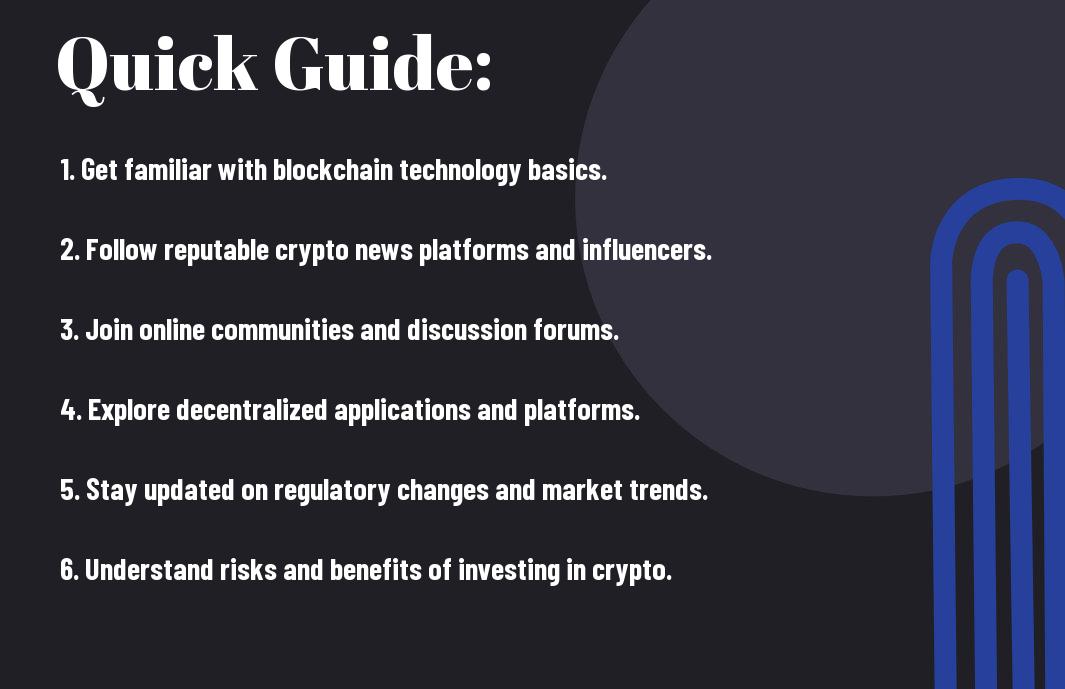Now Reading: Essential Steps For Understanding Web3 – Your Guide To Crypto News 2025
-
01
Essential Steps For Understanding Web3 – Your Guide To Crypto News 2025
Essential Steps For Understanding Web3 – Your Guide To Crypto News 2025

Just as the digital landscape evolves, so too must your understanding of Web3 and its implications for crypto news in 2025. This guide will equip you with the important steps to navigate this burgeoning frontier, highlighting the positive opportunities and the potential risks that come with it. You’ll discover how to engage with decentralized technologies effectively and responsibly. To further enhance your knowledge, check out How to Invest in Web3: A Beginner’s Roadmap for practical insights on entering this innovative space.
Key Takeaways:
- Web3 Revolution: The transition to Web3 signifies a shift from centralized platforms to decentralized systems, emphasizing user ownership and control over data.
- Blockchain Foundation: Understanding blockchain technology is important, as it serves as the backbone of Web3, enabling secure and transparent transactions.
- Crypto Integration: The rise of cryptocurrencies plays a pivotal role in Web3, facilitating peer-to-peer transactions and new economic models.
- Decentralized Applications (dApps): Familiarize yourself with dApps, which operate on a blockchain and offer innovative solutions beyond traditional applications.
- Community Engagement: Active participation in Web3 communities is key to staying updated on developments, trends, and opportunities within the crypto landscape.

Types of Web3 Technologies
A diverse array of technologies define the Web3 landscape, each serving unique purposes and capabilities. Understanding these types can significantly enhance your grasp of the revolution in the digital space. Here’s a breakdown of necessary technologies:
| Blockchain | The underlying architecture ensuring transparency and security. |
| Decentralized Applications (dApps) | Applications running on a distributed network. |
| Smart Contracts | Self-executing contracts with the terms directly written into code. |
| Interoperability Protocols | Facilitate communication between different blockchains. |
| Token Standards | Govern the creation and management of digital assets. |
Assume that mastering these types can empower your engagement in the Web3 ecosystem.
Blockchain
Now, you should familiarize yourself with blockchain technology, as it forms the backbone of most Web3 advancements. Blockchains are decentralized ledgers that record transactions in a secure and immutable manner, ensuring transparency and data integrity. You’ll find various blockchains catering to different requirements, and their functionality is vital for a wide range of applications.
Decentralized Applications (dApps)
Blockchain technology supports the development of dApps, which are applications that operate on a peer-to-peer network. These applications eliminate reliance on a central authority, offering you enhanced control over your data and interactions.
Technologies like Ethereum and Binance Smart Chain facilitate the creation of dApps, enabling features such as user-centric interfaces and seamless integration with other services. As a user, this means you can engage in decentralized finance, social networks, or gaming platforms without intermediaries, providing greater autonomy and potential financial reward.
Smart Contracts
Even more significant in the Web3 ecosystem are smart contracts, which automate and enforce agreements through code. These contracts execute transactions once predetermined conditions are met, removing the need for trust in intermediaries.
The real power of smart contracts lies in their efficiency and transparency; they facilitate rapid transactions while significantly reducing costs. With their growing implementation, you can enjoy streamlined processes in areas like insurance, real estate, and even voting systems, fostering a trustless environment where security is prioritized.
Essential Tips for Navigating Web3
Some important tips for navigating Web3 include:
- Stay updated with crypto news.
- Understand the basics of blockchain technology.
- Utilize secure wallets for your digital assets.
- Participate in decentralized finance (DeFi) platforms.
- Be wary of scams and always do your research.
Knowing these tips will greatly enhance your experience in the Web3 landscape.
Stay Informed on Latest Trends
Any effective strategy in Web3 requires you to stay informed about the latest trends. Follow reputable sources that provide insights on developments within the crypto market and blockchain technology. Subscribing to newsletters, engaging in podcasts, and utilizing social media can help you remain aware of new protocols, tokens, and changes in governance structures.
Engage with the Community
There’s a significant advantage in engaging with the community surrounding Web3. You can benefit from shared knowledge, network with like-minded individuals, and stay up to date with the latest happenings. Participate in online forums, attend virtual meetups, and connect with influential figures in the space to expand your understanding and maximize your opportunities.
Essentially, being part of the community allows you to gain valuable insights and avoid potential pitfalls. Engaging actively will not only enhance your knowledge but also give you access to exclusive information and opportunities through connections. Be cautious, however, as some individuals may attempt to manipulate or mislead. By building your network wisely, you can navigate Web3 more effectively and leverage collaboration for your advantage.
Step-by-Step Guide to Get Started with Crypto
Now, submerging into the world of cryptocurrency can be daunting, but following a systematic approach can make it simpler. Below is a table breaking down crucial steps to help you navigate the crypto landscape:
| Step | Action |
| 1 | Research Different Cryptos |
| 2 | Set Up a Digital Wallet |
| 3 | Choosing the Right Exchange |
| 4 | Making Your First Purchase |
Setting Up a Digital Wallet
StepbyStep, your first task is to set up a digital wallet. This wallet will securely store your cryptocurrencies, allowing you to manage and transact effortlessly. You can choose between a software wallet, which is convenient for day-to-day use, or a hardware wallet, which offers enhanced security for long-term storage. Select one that fits your usage needs and ensures the safety of your assets.
Choosing the Right Exchange
Now, selecting the right exchange is crucial for your trading experience. You’ll want an exchange that aligns with your trading goals, whether you aim to buy, sell, or trade various cryptocurrencies. Consider factors such as security, fees, and user interface when making your choice.
A well-chosen exchange can greatly influence your trading success. Look for an exchange that provides robust security measures, like two-factor authentication and cold storage for funds, to keep your assets safe. Additionally, evaluate the trading fees and the variety of currencies offered. The more user-friendly the interface, the easier it will be for you to navigate your trades.
Making Your First Purchase
For your first purchase, you will need to deposit funds into your selected exchange. This typically involves linking your bank account or credit card. The process is straightforward, but ensure you understand the associated fees and timelines for your transaction.
The initial purchase of cryptocurrency marks an important step in your investment journey. Once your funds are deposited, you can buy your chosen crypto. Always double-check the transaction details before confirming to avoid costly errors, as transactions can be irreversible. Approach your purchases thoughtfully, and consider starting with a modest amount to get familiar with the process.
Key Factors to Consider in Web3
Once again, understanding the landscape of Web3 requires a keen eye for several key factors. Here are some vital aspects to ponder:
- Security
- Privacy
- Scalability
- Performance
- Regulatory Considerations
Knowing these factors will empower you to navigate the Web3 ecosystem more effectively.
Security and Privacy
Factors impacting security and privacy in Web3 include the use of blockchain, decentralized identity systems, and user-controlled data. By prioritizing these elements, you can protect your assets and maintain your anonymity while engaging in the digital space.
Scalability and Performance
One of the significant aspects of Web3 is its scalability and performance. The ability to support increased transaction volumes and user growth without sacrificing speed is vital for any decentralized application.
To ensure optimal performance, you should look for platforms utilizing advanced layer-2 solutions and interoperability protocols. These innovations help reduce congestion and enhance user experience while maintaining high throughput, ensuring that your interactions on Web3 platforms are smooth and efficient.
Regulatory Considerations
Privacy in Web3 also brings forth various regulatory considerations that you need to factor in. As governments worldwide grapple with how to regulate digital currencies and decentralized technologies, staying informed about evolving laws is vital.
Plus, compliance with regulations may come with both challenges and opportunities. You should be aware that non-compliance can lead to severe penalties while adhering to regulations may boost your credibility and foster trust among users. Ultimately, navigating the regulatory landscape can help you thrive in the Web3 environment.
Pros and Cons of Web3 Adoption
For anyone stepping into Web3, understanding the pros and cons of its adoption is vital. Here’s a breakdown of key advantages and disadvantages:
| Pros | Cons |
|---|---|
| Enhanced security through decentralization | Scalability issues might arise |
| Ownership of digital assets | Regulatory uncertainty |
| Greater user privacy | Complex user experience |
| Access to new economic models | Market volatility |
| Increased transparency | Potential for misinformation |
Advantages of Decentralization
With the shift towards decentralization, you gain a sense of ownership and control over your data, reducing reliance on traditional intermediaries. This can lead to improved security, as well as fostering innovation and enhanced collaboration within digital communities.
Potential Risks and Challenges
Now, as you engage with Web3, it’s crucial to be aware of potential risks and challenges. While the benefits are promising, this new landscape presents uncertainties that can affect your experience and investments.
It’s important to consider that scalability issues could hinder performance as more users adopt the technology. Additionally, the lack of regulatory frameworks can lead to uncertainty and possible legal consequences. Market volatility may impact your investments significantly, and the *potential for misinformation* can distort fundamental narratives. Lastly, the complex user experience may pose hurdles, making it less accessible for newcomers who lack technical knowledge. Thus, balancing opportunities with these risks will be key for your success in the Web3 era.
Future Outlook for Web3 and Crypto News in 2025
Keep an eye on the rapid evolution of Web3 and crypto news as we approach 2025. You will likely witness an increased integration of blockchain technology across various industries, transforming how you interact online. The rise of decentralized finance (DeFi) could offer you greater financial freedom, while regulatory changes may bring both opportunities and challenges. As the landscape shifts, staying informed through trustworthy sources will be necessary for navigating risks and seizing potential benefits in your crypto journey.
Summing up
From above, it’s clear that understanding Web3 is vital for navigating the cryptocurrency landscape in 2025. You should familiarize yourself with the key concepts and technologies involved, ensuring you stay informed about the latest trends and developments. To deepen your knowledge, consider exploring resources like A Practical Guide to Web3, Blockchain, and Smart Contract…. By doing so, you’ll empower yourself to make informed decisions in the evolving world of crypto.
FAQ
Q: What are the fundamental principles of Web3?
A: The fundamental principles of Web3 revolve around decentralization, user control, and transparency. Unlike traditional web frameworks, Web3 aims to give users ownership of their data and digital assets, allowing for peer-to-peer interactions without intermediaries. Additionally, it utilizes blockchain technology to ensure that transactions and data remain secure and immutable, fostering a trustless environment for users.
Q: How does Web3 differ from Web2?
A: The primary difference between Web2 and Web3 lies in the level of control and ownership. Web2 predominantly focuses on user-generated content and social networks where users create and consume content while having little control over their data. In contrast, Web3 shifts the power back to users, allowing them to own their identities and their contributions. This is facilitated by decentralized applications (dApps) and blockchain technology, which empower users instead of central authorities.
Q: What role does cryptocurrency play in Web3?
A: Cryptocurrency is integral to the functioning of Web3 as it serves not only as a medium of exchange but also as a mechanism for incentivizing participation and governance. In the Web3 realm, cryptocurrencies enable users to transact directly with one another through smart contracts, eliminating the need for intermediaries. Additionally, they can be used to reward users who contribute resources or content to the ecosystem, thus enhancing engagement and community participation.
Q: How can individuals get started with Web3 technologies?
A: Individuals can start exploring Web3 technologies by educating themselves about blockchain, cryptocurrencies, and decentralized applications. Creating a digital wallet is an vital first step, as it allows users to store and manage their crypto assets securely. Additionally, users can explore various Web3 platforms to understand their functionalities, participate in online forums, and engage with communities to learn about best practices and emerging trends in the space.
Q: What are some common challenges associated with Web3 adoption?
A: Despite its potential, Web3 faces several challenges to mass adoption. Technical barriers such as complex user interfaces and the need for users to understand blockchain technology can impede accessibility. Furthermore, regulatory uncertainties surrounding cryptocurrencies and decentralized platforms may create skepticism among potential users. Lastly, security concerns related to hacking and scams pose significant risks that need to be addressed for broader acceptance of Web3 technologies.
























